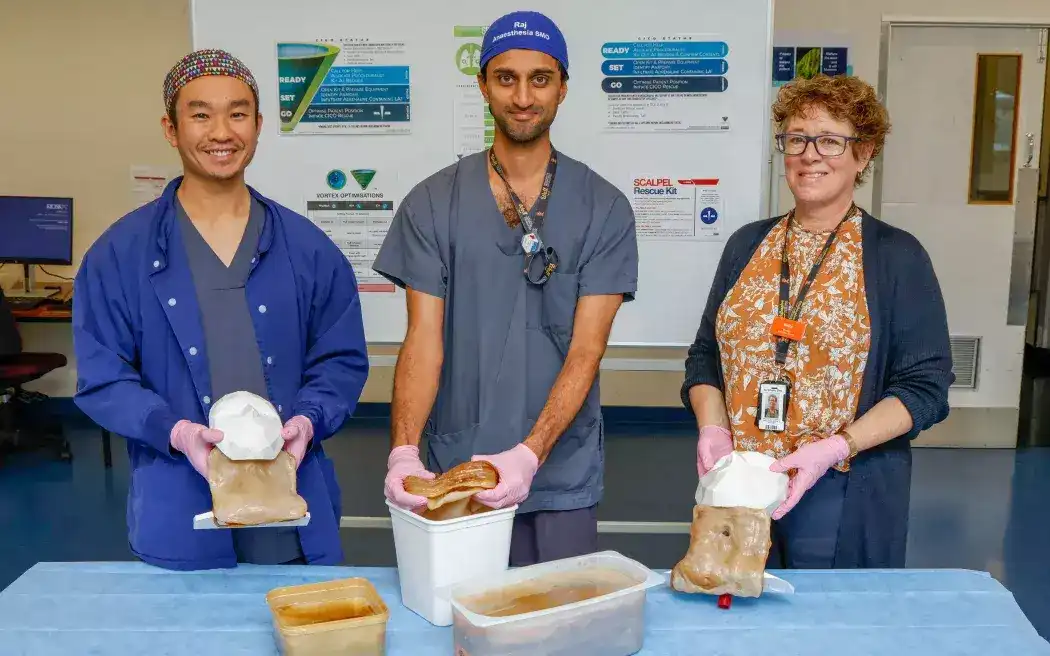Using Scoby to help train our future clinicians
Posted 16 February 2025

Inside Wellington Regional Hospital, a team is brewing kombucha to use its gelatinous by-product as a stand-in for human flesh and skin.
Scoby, the cellulose layer that forms on top of the fermented tea drink, consists of bacteria and yeast. It is also known as the 'mother'.
Melita Macdonald, the Simulation Service Manager at Wellington Regional Hospital, shared on RNZ's Nights programme that scoby is an excellent replacement for human tissue.
"Without freaking people out, it looks and feels like skin or even muscle... we've looked at it under ultrasound and it looks more like a human than a blob of gel," Macdonald said.
Two and a half years ago, they learned that people in Canterbury were using scoby to practice suturing skills. Macdonald then visited KB Kombucha on Taranaki Street.
"I think he thought I was mad, but he gave me a starter with some scoby in it, which I took back to the hospital on the bus and we started from there," she said.
Now, anaesthetists, emergency department clinicians, medical school trainees, and nurses use scoby grown in the hospital to practice not just stitches but also cricothyroidotomy (an incision to create an emergency airway), intravenous cannulation, and lumbar puncture (or spinal taps).
Macdonald, known as the 'Scoby Mother', said it was a great replacement for the non-biodegradable products previously used.
"They're made out of silicon or rubber or foam, which just doesn't look and feel like a real person," she said.
The plastic, rubber, or foam would end up in the landfill, could be expensive, and the scoby was often more realistic.
"If they're fresh in the tea, they are slimy. We actually use them once we've dried them out for a number of hours, sort of 12 to 20 hours depending on what we're doing with them. At that stage, they're quite pliable, you could think it's the fat off a piece of meat, it's that kind of texture."
They've also been trying to grow things in the scoby to replicate nerves and fascia.
"The more realistic the material, the better people will learn," Macdonald said. "It's a place where people can make mistakes and no patients are harmed."
However, they don't drink the kombucha. Macdonald mentioned she had never even tried it.
"We're putting our fingers and all sorts of things into this stuff, I wouldn't be drinking it.
"My office is right next to the scoby farm and yeah, there's a distinct whiff of vinegar when we open the door."
More than just scoby An occupational therapist by trade, Macdonald has worked in health for more than 30 years and loves the innovation of her role.
"This is a fun part of my job. The rest of my job, I suppose, is more strategic, but it is really aligned to improving patient outcomes and staff safety as well."
And it's not just the scoby the simulation team uses to help people practice and learn.
"We have a birthing mannequin, one of the few mannequins in New Zealand that gives birth to another mannequin."
This allows obstetricians, midwives, and anaesthetists to practice emergency procedures.
There is also an aeroplane fuselage where flight teams, ICU, and NICU staff can practice working in a confined moving space.
Additionally, volunteers come in and pretend to be a patient or a family member to practice the communication and emotional aspects of medicine.
The New Zealand Health Innovation Hub (NZHIH) is now offering commercialisation support to this innovative team, helping them bring their scoby-based training tools to a wider audience. This support aims to enhance the development and distribution of these realistic and sustainable medical training aids, ensuring that more healthcare professionals can benefit from this groundbreaking approach.